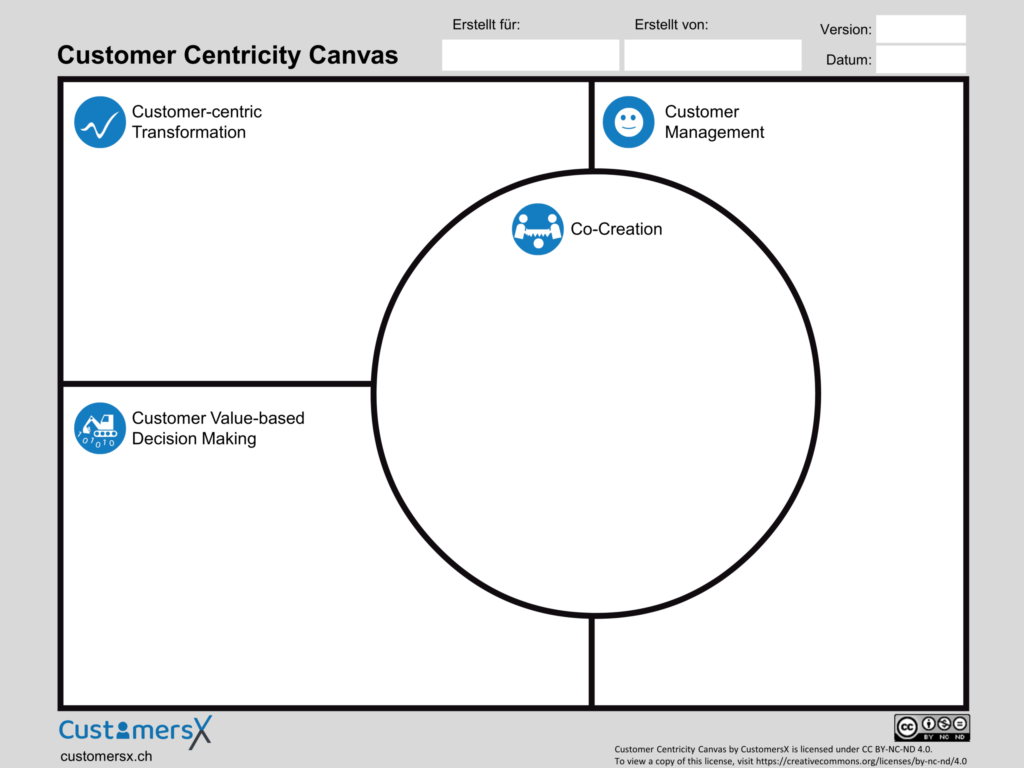Customer centricity
As early as the 1990s, the positive correlation between customer centricity (customer excellence) and corporate success was empirically proven as part of success factor research. Despite all the confusion, customer excellence has steadily gained in importance in recent years – not least because several studies have shown that organizations whose customer excellence is at a high level have an average of 3 to 5% higher profitability. Due to the increasing interchangeability of offers, brands and experiences and the ever faster imitation of innovations by competitors, the only option is to turn more towards the customer.
Customer Excellence is a mindset as well as a management model consisting of four different dimensions:
- Customer Value-based Decision Making: Those responsible should make decisions in such a way that customer value (customer-firm value) increases continuously.
- Customer-centric transformation: Customer excellence should be understood as a continuous transformation process that ensures responsiveness to possible changes in customer attitudes and behavior.
- Co-creation: At its core, customer excellence serves to integrate the customer into the organization in the most value-creating way possible.
- Customer Management: As a result, the organization is enabled to establish differentiating customer management that can establish and develop more valuable relationships with customers than the competition.
Consulting offer Customer centricity
Customer centricity is on everyone’s lips. In this context, it is not enough to define inspiring experiences or experiences that are as simple as possible. The aim is to ensure the company’s adaptability to changes in customers’ purchasing behavior. As a specialized customer centricity consultancy, we have the tools and experience to successfully support you in your transformation to improve customer centricity.
Customer Centricity Canvas
With the help of the Customer Centricity Canvas, you can evaluate the strengths and weaknesses of your company’s customer excellence and systematically define measures to improve it.
Derivation of the term customer orientation
Looking at the first definitional approaches, it is noticeable that customer excellence was contrasted with supply orientation. Although this sounds plausible at first glance (e.g., the automotive industry, which still uses the car and not the customer as an identification element in its CRM systems), it does not go far enough, because there are certainly successful organizations that focus on the offering and could still be customer-oriented. This definitional approach also lacks a clearly delineated management model. The offer is the insufficient core of the benefit for the customer and can only be philosophically delimited in terms of customer excellence. The level of customer excellence always has an impact on the range of products and services offered by an organization.
In the years that followed, customer excellence was understood as a universal fixed star that uniquely drives all life in the organization. Sounds good, but is not very helpful in the day-to-day business of an executive. Also, the fact that the definition of customer excellence has changed extensively over time has meant that everyone understands something different about customer excellence. The lack of a model with different elements and contexts makes it impossible for many employees to understand how customer-oriented their own organization is in the first place. Other works on the topic of customer excellence see their task primarily in establishing a customer-focused organizational culture. The culture of an organization is an important building block for success. But as the name suggests, customer orientation is geared to the customer and (again!) not just to the organization. Most English-speaking authors equate customer excellence with customer experience or customer excellence with customer experience. This offers no discernible added value for management. Customer experience is an important element of customer excellence, but it is only one. Other authors reduce customer excellence to the use of customer insights. This understanding builds on the knowledge orientation. From the mid-1990s, a knowledge-based view of organizations became established and the primacy of knowledge and intellectual capital as the most important potential of an organization was emphasized. Consequently, the knowledge and learning ability of employees are the primary source of competitive advantage and the basis of an organization’s ability to survive. A knowledge-based organization transfers existing knowledge and skills into services that allow it to better meet its challenges. Transferred to customer management, the term “market-based learning” was introduced. As with culture, focusing solely on an organization’s knowledge development falls short. The understanding of customer orientation as a craft proves, as with any craft, the high value placed on knowledge. But there are other elements to consider. It remains to be said that, on the basis of knowledge orientation, customer information is an important component of customer excellence. Simply obtaining customer information is not sufficient for improving customer excellence. There are still many organizations that do not conduct high-quality customer surveys. It turns out – and this is shared with great frustration by many market researchers and data analysts in most conversations – that customer information is often not used to make decisions. Customer excellence does not stop at the production of customer insights, but these must then be used for as many decisions as possible in the organization.
In addition, some authors see customer excellence as the equivalent of customer relationship management. This also results in no real added value, or the sense of using two terms for an identical management model is not comprehensible. Furthermore, there are approaches that try to define customer orientation by several terms, e.g.. Total Experience, Customer Obsession or Insight Engine. The selection of terms seems indiscriminate and the terminology partly scary. Who wants to be obsessed?
At first glance, therefore, there are numerous different understandings of the term customer excellence. In most cases, customer excellence is defined far too narrowly, making it difficult to distinguish it from terms such as “customer service” or “customer excellence”. Customer Data Management, Customer Experience Management or Customer Relationship Management. The more complex attempts at definition focus more on the goal of driving a proverbial new sow through the village than on establishing an effective management model. Customer excellence thus runs the risk of becoming, like digitization, a hollow word that no one understands but which attracts moths like light.
Customer Excellence consists of four dimensions and pursues the goal of increasing growth and profits by better adapting to changes in customer purchasing behavior. No more, but also no less.




